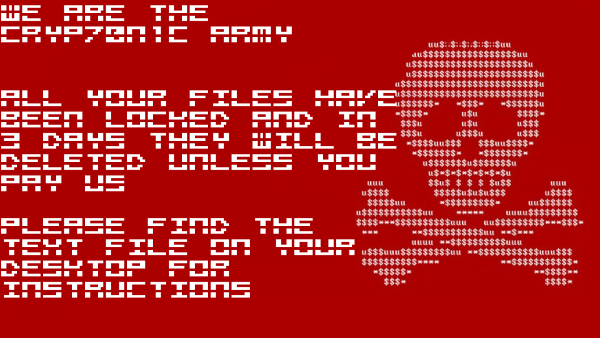RANSOM_HIDDENTEAR.CRYPKILT
HEUR:Trojan.Win32.Generic (Kaspersky); Ransom.HiddenTear.Generic (Malwarebytes); Ransom.HiddenTear!g1 (Symantec)
Windows


Threat Type: Ransomware
Destructiveness: No
Encrypted: No
In the wild: Yes
OVERVIEW
This Ransomware arrives on a system as a file dropped by other malware or as a file downloaded unknowingly by users when visiting malicious sites.
It creates folders where it drops its files.
It connects to certain websites to send and receive information.
It encrypts files with specific file extensions. It encrypts files found in specific folders. It drops files as ransom note.
TECHNICAL DETAILS
Arrival Details
This Ransomware arrives on a system as a file dropped by other malware or as a file downloaded unknowingly by users when visiting malicious sites.
Installation
This Ransomware drops the following copies of itself into the affected system:
- C:\{User Name}\Rand123\local.exe
Other System Modifications
This Ransomware sets the system's desktop wallpaper to the following image:
Download Routine
This Ransomware connects to the following URL(s) to download its component file(s):
- https://i.{BLOCKED}r.com/{BLOCKED}0.jpg
It saves the files it downloads using the following names:
- C:\{User Name}\ransom.jpg -> used as wallpaper
Other Details
This Ransomware connects to the following URL(s) to check for an Internet connection:
- https://www.google.com
It connects to the following website to send and receive information:
- https://{BLOCKED}n1c.army/Cryp70n1c-Army-Dooms-Pepper/write.php
Ransomware Routine
This Ransomware encrypts files with the following extensions:
- .txt
- .jar
- .exe
- .dat
- .contact
- .settings
- .doc
- .docx
- .xls
- .xlsx
- .ppt
- .pptx
- .odt
- .jpg
- .png
- .csv
- .py
- .sql
- .mdb
- .sln
- .php
- .asp
- .aspx
- .html
- .htm
- .xml
- .psd
- .dll
- .c
- .cs
- .mp3
- .mp4
- .f3d
- .dwg
- .cpp
- .zip
- .rar
- .mov
- .rtf
- .bmp
- .mkv
- .avi
- .apk
- .lnk
- .iso
- .7-zip
- .ace
- .arj
- .bz2
- .cab
- .gzip
- .lzh
- .tar
- .uue
- .xz
- .z
- .001
- .mpeg
- .mp3
- .mpg
- .core
- .crproj
- .pdb
- .ico
- .pas
- .db
- .torrent
- .sai
- .mdb
- .mdf
- .ldf
- .dbf
- .wdb
- .xlsx
- .123
- .pst
- .mbx
- .dbx
- .edb
- .qbb
- .pay
- .acu
- .drw
- .dwg
- .dwf
- .tct
- .tcw
- .psd
- .ai
- .mp4
It encrypts files found in the following folders:
- %Desktop%
- %User Profile%\Links
- %User Profile%\Contacts
- %User Profile%\Documents
- %User Profile%\Downloads
- %User Profile%\Pictures
- %User Profile%\Music
- %User Profile%\OneDrive
- %User Profile%\Saved Games
- %User Profile%\Favorites
- %User Profile%\Searches
- %User Profile%\Videos
(Note: %Desktop% is the desktop folder, where it usually is C:\Documents and Settings\{user name}\Desktop in Windows 2000, Windows Server 2003, and Windows XP (32- and 64-bit); C:\Users\{user name}\Desktop in Windows Vista (32- and 64-bit), Windows 7 (32- and 64-bit), Windows 8 (32- and 64-bit), Windows 8.1 (32- and 64-bit), Windows Server 2008, and Windows Server 2012.. %User Profile% is the current user's profile folder, which is usually C:\Documents and Settings\{user name} on Windows 2000, XP, and Server 2003, or C:\Users\{user name} on Windows Vista and 7.)
It appends the following extension to the file name of the encrypted files:
- .cryp70n1c
It drops the following file(s) as ransom note:
- %Desktop%\READ_IT.txt
(Note: %Desktop% is the desktop folder, where it usually is C:\Documents and Settings\{user name}\Desktop in Windows 2000, Windows Server 2003, and Windows XP (32- and 64-bit); C:\Users\{user name}\Desktop in Windows Vista (32- and 64-bit), Windows 7 (32- and 64-bit), Windows 8 (32- and 64-bit), Windows 8.1 (32- and 64-bit), Windows Server 2008, and Windows Server 2012.)
It leaves text files that serve as ransom notes containing the following text:
- This computer has been hacked
Your personal files have been encrypted. Send us 0,05 Bitcoin to get the decryption passcode.
After that, you'll be able to get your files back again.
Failure to do so within 3 days will result in all your files being deleted & lost forever - visit www.luno.com to buy Bitcoin and once you have purchased 0.05 please send them to the following Bitcoin Address {BLOCKED} thank you and have a great day. If you need to contact us for any reason please e-mail us {BLOCKED}
SOLUTION
Step 1
Before doing any scans, Windows XP, Windows Vista, and Windows 7 users must disable System Restore to allow full scanning of their computers.
Step 2
Note that not all files, folders, and registry keys and entries are installed on your computer during this malware's/spyware's/grayware's execution. This may be due to incomplete installation or other operating system conditions. If you do not find the same files/folders/registry information, please proceed to the next step.
Step 3
Search and delete this folder
- C:\{User Name}
Step 4
Search and delete this file
- %Desktop%\READ_IT.txt
Step 5
Scan your computer with your Trend Micro product to delete files detected as RANSOM_HIDDENTEAR.CRYPKILT. If the detected files have already been cleaned, deleted, or quarantined by your Trend Micro product, no further step is required. You may opt to simply delete the quarantined files. Please check the following Trend Micro Support pages for more information:
Step 6
Restore encrypted files from backup.
Step 7
Reset your Desktop properties
Did this description help? Tell us how we did.


